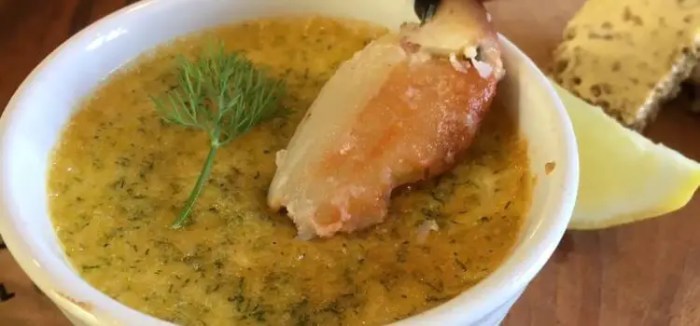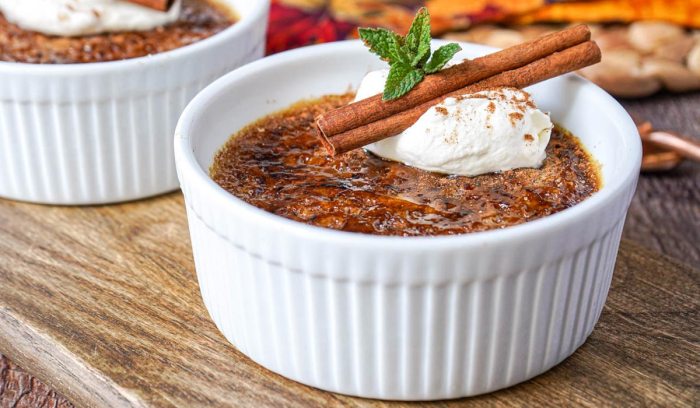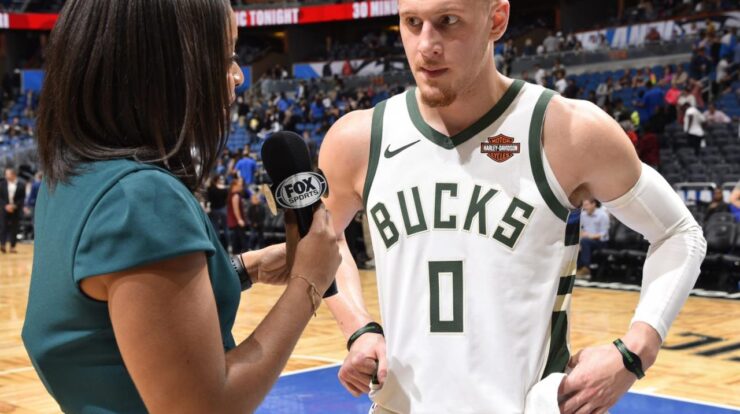
Embark on a culinary adventure with our crab brulee recipe, where the delicate flavors of crab dance harmoniously with the caramelized crust of a brulee. This delectable dish is a symphony of textures and tastes, sure to tantalize your palate and impress your guests.
From the selection of the perfect crab to the art of caramelization, we’ll guide you through every step of creating this culinary masterpiece. Let’s dive into the world of crab brulee and explore its exquisite flavors.
Culinary Techniques

The brulee technique involves caramelizing a sugar topping on a dish, creating a crispy and flavorful crust. When applied to crab dishes, this technique adds a delightful contrast to the delicate and succulent meat.
To preserve the delicate flavor of crab in a brulee, it is crucial to use a gentle cooking method. Steaming or poaching the crabmeat before incorporating it into the brulee mixture helps retain its natural sweetness and prevents overcooking.
Another seafood dish that I’ve been craving lately is crab brulee . It’s a creamy, cheesy dish that’s perfect for a special occasion. The best part is that it’s surprisingly easy to make. Just be sure to use fresh crab meat for the best flavor.
Optimal Cooking Methods
- Steaming:Steaming crabmeat over a pot of boiling water allows it to cook evenly without losing its moisture or flavor.
- Poaching:Poaching crabmeat in a flavorful broth gently cooks it while infusing it with additional flavors.
Once the crabmeat is cooked, it can be incorporated into a custard-like mixture made with eggs, cream, and seasonings. The mixture is then poured into ramekins or a baking dish and topped with a layer of sugar. The dish is then placed under a broiler or in a preheated oven until the sugar caramelizes and forms a golden-brown crust.
The brulee technique adds a touch of elegance and sophistication to crab dishes, enhancing their flavor and texture. By following these culinary techniques, you can create a memorable and delicious crab brulee that will impress your guests.
Ingredient Selection

Selecting the ideal crab species and high-quality ingredients is crucial for crafting an exceptional crab brulee. Let’s delve into the key factors to consider:
Crab Species, Crab brulee recipe
The choice of crab species significantly impacts the flavor and texture of the brulee. Blue crabs, known for their sweet and delicate meat, are a popular option. Dungeness crabs, with their firm and slightly sweet flesh, are also suitable. Avoid using crabs with a strong fishy odor or excessive moisture, as these qualities can compromise the dish’s flavor.
Crab Quality
Fresh, high-quality crab is essential. Look for crabs with a firm shell, bright eyes, and a clean, briny aroma. Avoid crabs with cracked or broken shells, as this can indicate spoilage. Opt for crabs that are well-refrigerated or live if possible.
Additional Ingredients
In addition to crab, various ingredients contribute to the flavor profile of crab brulee. Heavy cream and eggs provide a rich, custard-like base. Butter adds a velvety texture and enhances the crab’s natural sweetness. Seasonings, such as Old Bay or cayenne pepper, add depth and complexity.
Panko breadcrumbs or crushed crackers create a crispy topping that contrasts with the delicate filling.
Have you ever heard of a dish called “chicken of the woods”? It’s a mushroom that looks like a chicken and tastes surprisingly like one too! If you’re looking for a unique and flavorful vegetarian dish, I highly recommend trying out this chicken of the woods recipe . It’s easy to make and absolutely delicious.
Recipe Variations
Crab brulee is a versatile dish that can be customized to suit various tastes and preferences. Several variations of this classic recipe exist, each offering a unique take on its flavors and presentation. The following table provides a comparison of some popular crab brulee recipes, highlighting their distinct characteristics:
The choice of crab brulee recipe depends on the occasion and personal preferences. For a sophisticated dinner party, a classic crab brulee with a delicate and elegant presentation might be suitable. For a casual gathering, a more rustic version with bolder flavors and a simpler presentation could be a better choice.
Ingredients
- Classic Crab Brulee:Features a combination of crab meat, cream, eggs, and seasonings, baked in individual ramekins and topped with a crispy caramelized sugar crust.
- Seafood Crab Brulee:Incorporates a variety of seafood, such as shrimp, scallops, and lobster, along with crab meat, creating a rich and flavorful dish.
- Crab and Corn Brulee:Combines crab meat with sweet corn kernels, adding a touch of sweetness and texture to the dish.
- Crab and Asparagus Brulee:Includes asparagus spears, providing a delicate and slightly bitter flavor to balance the sweetness of the crab.
Cooking Methods
- Baked:The most common method, involves baking the crab brulee in a water bath to ensure even cooking and a creamy texture.
- Sous Vide:A modern technique that involves cooking the crab brulee in a vacuum-sealed bag submerged in a precisely controlled water bath, resulting in a tender and juicy texture.
- Broiled:A quick and easy method that involves broiling the crab brulee for a few minutes to create a crispy crust on top.
Presentation Styles
- Individual Ramekins:The traditional presentation, where the crab brulee is baked and served in individual ramekins, allowing for easy portion control.
- Tartlet Shells:A more elegant option, where the crab brulee is baked in tartlet shells, creating a delicate and visually appealing presentation.
- Phyllo Pastry Cups:A creative presentation that involves using phyllo pastry cups as the base for the crab brulee, adding a crispy and flaky element to the dish.
Presentation and Garnishes: Crab Brulee Recipe
Crab brulee is typically presented in individual ramekins or gratin dishes. The ramekins are filled with the crab mixture and then topped with a layer of bread crumbs or crushed crackers. The brulee is then baked until the topping is golden brown and the crab mixture is set.
There are many creative variations on the traditional presentation of crab brulee. For example, the brulee can be served in a variety of shapes and sizes, such as individual portions or a large family-style dish. The topping can also be varied, such as using different types of bread crumbs or crackers, or even using a layer of cheese or breadcrumbs.
Additionally, the brulee can be garnished with a variety of items, such as fresh herbs, lemon wedges, or even caviar.
Garnishes
Garnishes can play an important role in enhancing the presentation and flavor of crab brulee. Some good choices for garnishes include:
- Fresh herbs, such as chives, parsley, or dill
- Lemon wedges
- Caviar
- Crab meat
- Bread crumbs
- Crushed crackers
When choosing garnishes, it is important to consider the flavors and textures of the crab brulee. For example, fresh herbs can add a bright and refreshing flavor, while lemon wedges can add a touch of acidity. Caviar can add a touch of luxury, while crab meat can add a bit of extra protein.
Bread crumbs and crushed crackers can add a crunchy texture.
Presentation Enhances Dining Experience
The presentation of crab brulee can play an important role in enhancing the overall dining experience. A well-presented dish is more appealing to the eye and can make the food taste even better. Additionally, the presentation can help to create a special occasion or atmosphere.
Flavor Pairing and Wine Recommendations

Crab brulee is a delicate and flavorful dish that pairs well with a variety of complementary flavors. When selecting a wine to accompany crab brulee, consider the dish’s rich and creamy texture, as well as its subtle seafood flavor.
Some great flavor pairings for crab brulee include:
- Citrus:The acidity of citrus fruits, such as lemon or grapefruit, can help to cut through the richness of the crab brulee and brighten its flavors.
- Herbs:Fresh herbs, such as basil or chives, can add a touch of herbaceousness to crab brulee, complementing its seafood flavor.
- Seafood:Other types of seafood, such as shrimp or scallops, can be added to crab brulee to enhance its seafood flavor.
Wine Recommendations
When selecting a wine to accompany crab brulee, consider the following:
- Body:The wine should have a light to medium body, so as not to overpower the delicate flavors of the crab brulee.
- Acidity:The wine should have a moderate to high acidity, to help cut through the richness of the crab brulee.
- Flavor:The wine should have a subtle flavor, so as not to compete with the delicate flavors of the crab brulee.
Some specific wine recommendations that pair well with crab brulee include:
- Pinot Grigio:This Italian white wine is light-bodied and has a crisp acidity, making it a great choice for pairing with crab brulee.
- Sauvignon Blanc:This French white wine is also light-bodied and has a crisp acidity, as well as a subtle citrus flavor that pairs well with crab brulee.
- Chardonnay:This French white wine is a bit fuller-bodied than Pinot Grigio or Sauvignon Blanc, but it still has a moderate acidity and a subtle flavor that makes it a good choice for pairing with crab brulee.
Wrap-Up

As we conclude our culinary journey, we hope you’ve gained a newfound appreciation for the art of crab brulee. Whether you’re a seasoned chef or a home cook looking to impress, this recipe will elevate your culinary skills and delight your taste buds.
Remember, cooking should be an enjoyable and experimental process. Don’t be afraid to experiment with different ingredients and techniques to create your own unique crab brulee masterpiece.
Top FAQs
What type of crab is best for brulee?
Blue crab or Dungeness crab are ideal choices due to their delicate and sweet flavor.
How do I achieve the perfect caramelized crust?
Use a kitchen torch or oven broiler to evenly caramelize the sugar topping, creating a golden-brown and crispy crust.
Can I make crab brulee ahead of time?
Yes, you can prepare the crab mixture and refrigerate it for up to 24 hours before baking.





